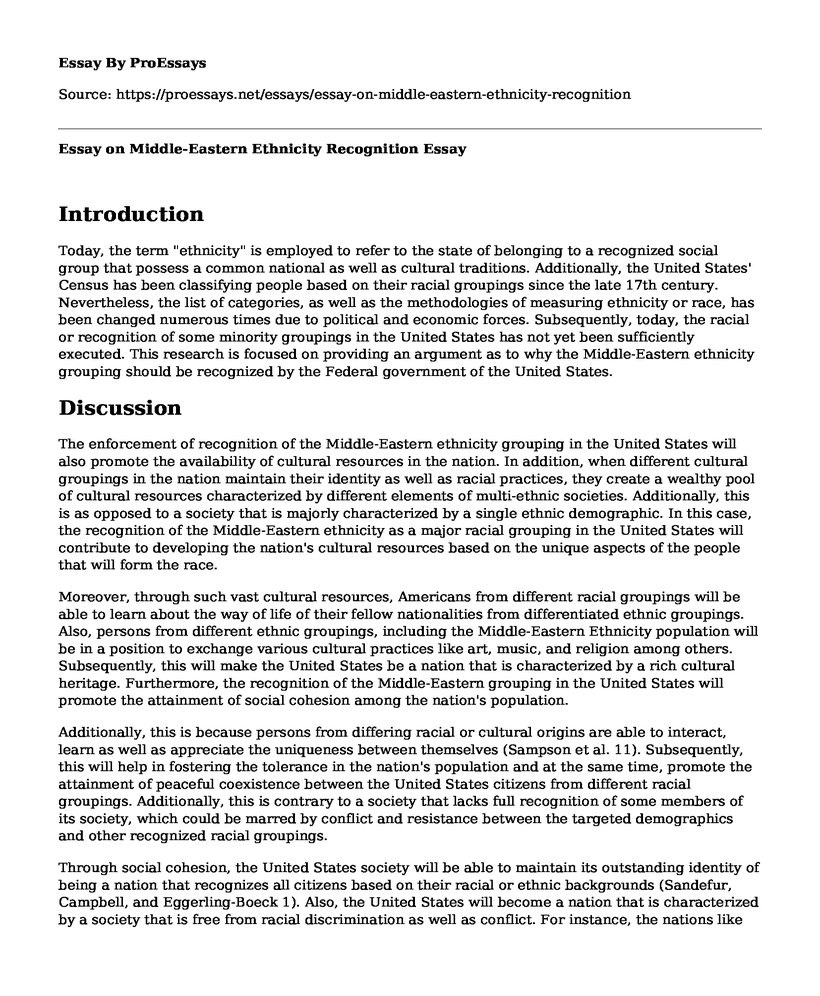Introduction
Today, the term "ethnicity" is employed to refer to the state of belonging to a recognized social group that possess a common national as well as cultural traditions. Additionally, the United States' Census has been classifying people based on their racial groupings since the late 17th century. Nevertheless, the list of categories, as well as the methodologies of measuring ethnicity or race, has been changed numerous times due to political and economic forces. Subsequently, today, the racial or recognition of some minority groupings in the United States has not yet been sufficiently executed. This research is focused on providing an argument as to why the Middle-Eastern ethnicity grouping should be recognized by the Federal government of the United States.
Discussion
The enforcement of recognition of the Middle-Eastern ethnicity grouping in the United States will also promote the availability of cultural resources in the nation. In addition, when different cultural groupings in the nation maintain their identity as well as racial practices, they create a wealthy pool of cultural resources characterized by different elements of multi-ethnic societies. Additionally, this is as opposed to a society that is majorly characterized by a single ethnic demographic. In this case, the recognition of the Middle-Eastern ethnicity as a major racial grouping in the United States will contribute to developing the nation's cultural resources based on the unique aspects of the people that will form the race.
Moreover, through such vast cultural resources, Americans from different racial groupings will be able to learn about the way of life of their fellow nationalities from differentiated ethnic groupings. Also, persons from different ethnic groupings, including the Middle-Eastern Ethnicity population will be in a position to exchange various cultural practices like art, music, and religion among others. Subsequently, this will make the United States be a nation that is characterized by a rich cultural heritage. Furthermore, the recognition of the Middle-Eastern grouping in the United States will promote the attainment of social cohesion among the nation's population.
Additionally, this is because persons from differing racial or cultural origins are able to interact, learn as well as appreciate the uniqueness between themselves (Sampson et al. 11). Subsequently, this will help in fostering the tolerance in the nation's population and at the same time, promote the attainment of peaceful coexistence between the United States citizens from different racial groupings. Additionally, this is contrary to a society that lacks full recognition of some members of its society, which could be marred by conflict and resistance between the targeted demographics and other recognized racial groupings.
Through social cohesion, the United States society will be able to maintain its outstanding identity of being a nation that recognizes all citizens based on their racial or ethnic backgrounds (Sandefur, Campbell, and Eggerling-Boeck 1). Also, the United States will become a nation that is characterized by a society that is free from racial discrimination as well as conflict. For instance, the nations like Switzerland as well as Indonesia are globally renowned for having multi-ethnic societies marked with peaceful coexistence of people. Ultimately, the recognition of the Middle-Eastern ethnicity grouping in the United States will promote the economic development of the nation. Additionally, this is because persons originating from different ethnic groupings have differing ideas, expertise as well as experiences that could be beneficial to the United States economy.
Conclusion
In conclusion, the recognition of the Middle-Eastern ethnicity grouping in the United States will help the nation to attain social cohesion between its people. Also, the United States will be a nation rich in cultural resources provided by different cultures including the Middle-Eastern ethnicity grouping. Ultimately, the acknowledgment and recognition of the Middle-Eastern ethnicity grouping will aid in promoting the economic development of the United States.
Works Cited
Sampson, Frederic, et al. "Investing In Cultural Diversity and Intercultural Dialogue." UNESCO World Report (2009): 11-13. Print.
Sandefur, Gary D., Mary E. Campbell and Jennifer Eggerling-Boeck. "Racial and Ethnic Identification, Official Classifications, and Health Disparities." Critical Perspectives on Racial and Ethnic Differences in Health in Late Life (2004). Print.
Cite this page
Essay on Middle-Eastern Ethnicity Recognition. (2022, Jun 05). Retrieved from https://proessays.net/essays/essay-on-middle-eastern-ethnicity-recognition
If you are the original author of this essay and no longer wish to have it published on the ProEssays website, please click below to request its removal:
- The Potential Support That the Client Needs in Family Breakdown
- Essay Sample on Corporate Social Responsibility and Competitive Advantage
- Women's Indian Captivity Narratives - Essay Sample
- Why Love Hurts - Essay Sample
- Essay Sample on Codependency in Addiction: A Case Study of Coleen
- A Closer Look at How Storybook Reading Can Impact Child Wellness - Essay Sample
- Paper Sample on Cultural Theory: Explaining Jewish vs Italian Immigrants in America 1910-1914







